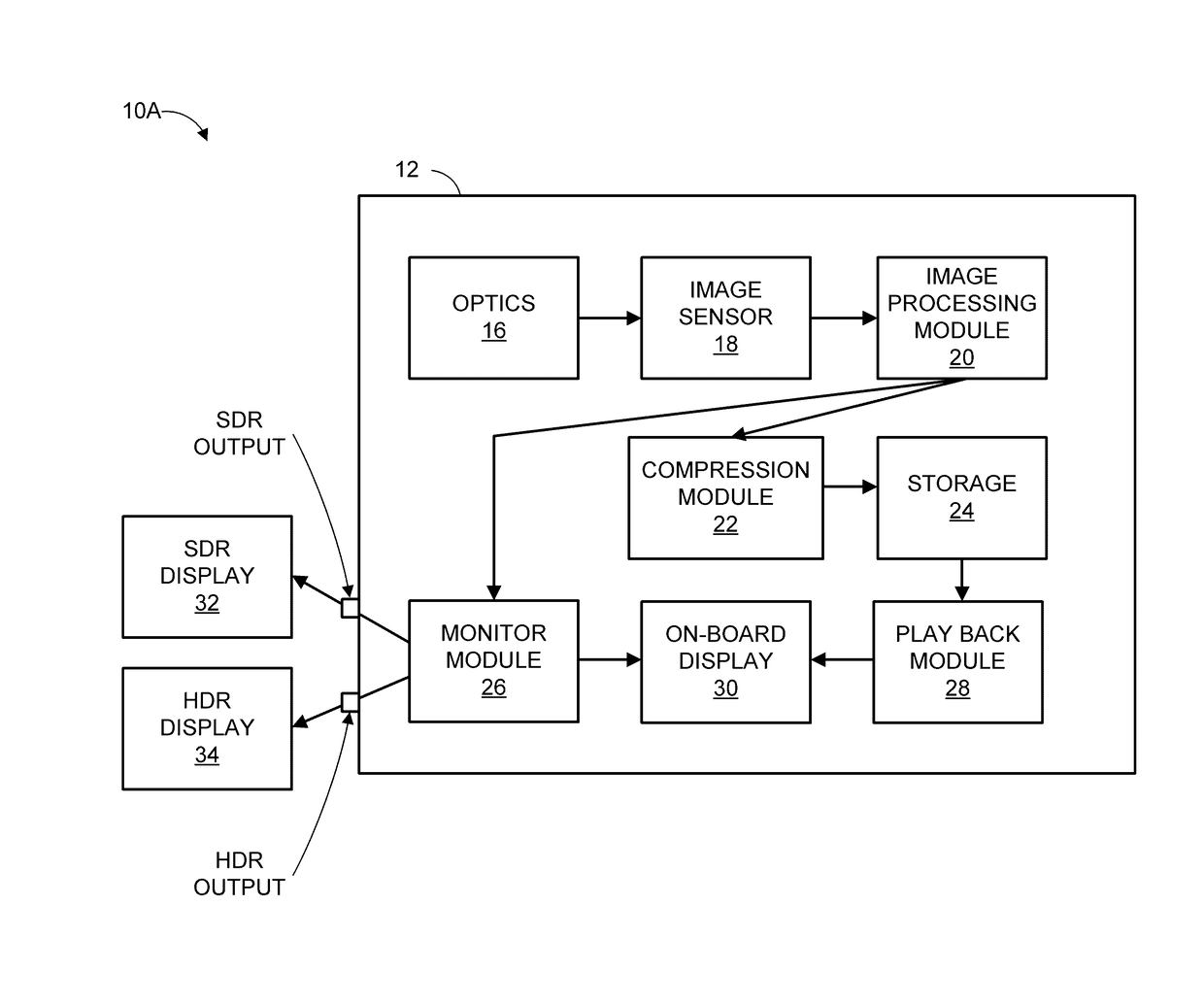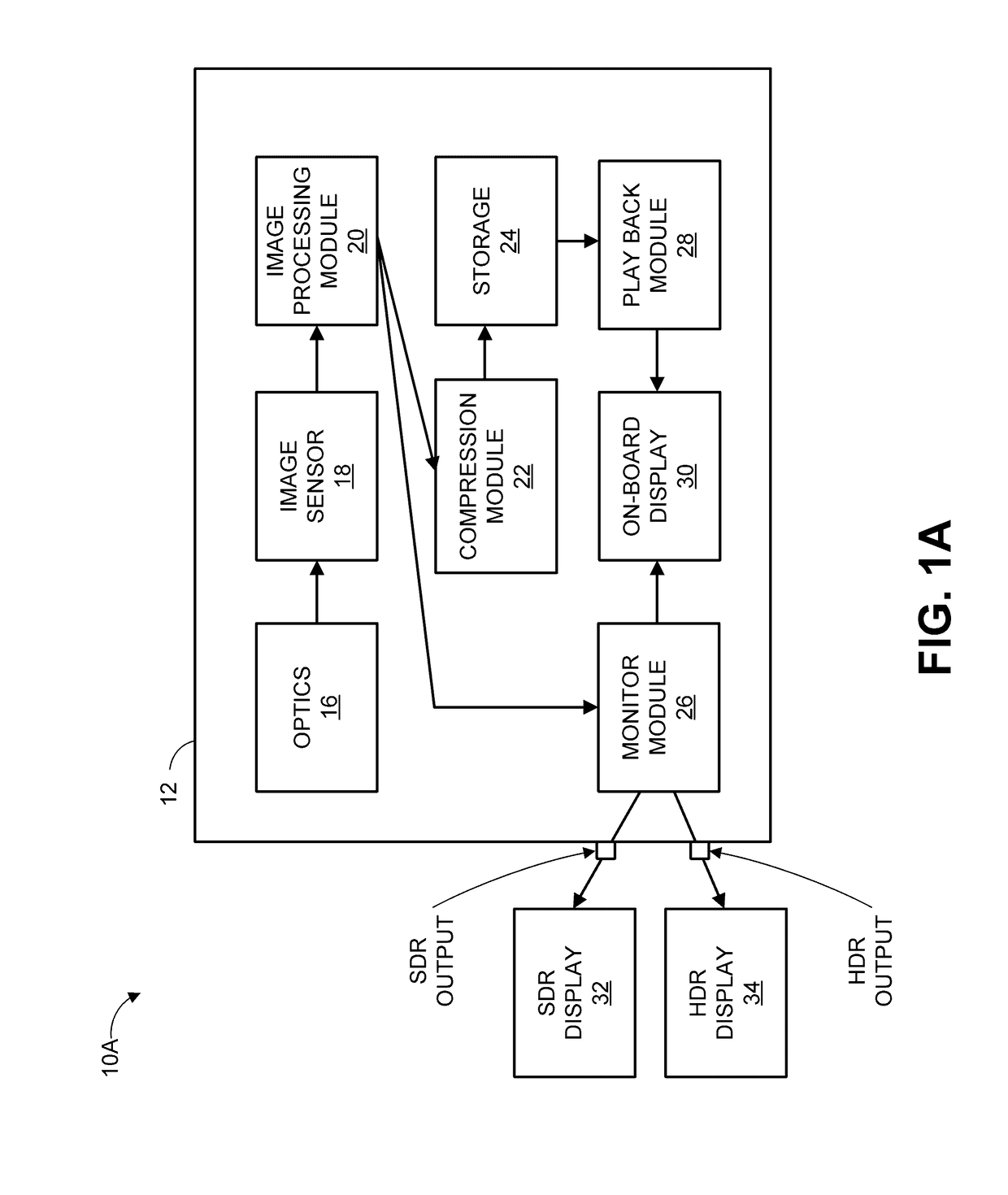Motion video output for multiple displays
a technology of motion video and multiple displays, applied in the field of digital cameras, can solve the problems of unsatisfactory effects of images displayed on displays, unnatural and unrealistic appearance, and less desirable hue twisting, so as to reduce highlights, narrow the brightness range, and reduce highlights.
- Summary
- Abstract
- Description
- Claims
- Application Information
AI Technical Summary
Benefits of technology
Problems solved by technology
Method used
Image
Examples
first example
Camera System
[0081]FIG. 3A is a perspective view of a front of a brain module 100 of a modular camera system. The brain module 100 can include a housing 102 (sometimes referred to as a body) that contains and supports the components of the brain module 100. The brain module 100 can be an example implementation of the camera 12 of FIG. 1B. More details about a brain module, such as the brain module 100, and related camera components are provided in U.S. patent application Ser. No. 15 / 094,693, entitled “MODULAR MOTION CAMERA,” filed Apr. 8, 2016, which is incorporated by reference herein in its entirety.
[0082]The housing 102 can include one or more top surface interfaces for mechanically or electrically coupling one or more modules to a top of the housing 102. One of the top surface mounting interfaces can include a first module connector 110 and mounting holes 112A, 112B for electrically and mechanically coupling a module, such as a display module (for instance, a liquid-crystal disp...
second example
Camera System
[0096]FIG. 5A is a front perspective view of a brain module 512 of a modular camera system releasably coupled with a lens mount module 514 and a lens 516. FIG. 5B is a back perspective view of the brain module 512 releasably coupled with the lens mount module 514 and the lens 516. The brain module 512 can be an example implementation of the camera 12 of FIG. 1A or FIG. 1B. The brain module 512 can include various connectors 501 for providing data input or output. In various embodiments, such connectors 501 include a SDR output (such as described with respect to FIG. 1A), a HDR output (such as described with respect to FIG. 1A), one or more video (e.g., HDMI, BNC), audio in and out, data or power connectors. The brain module 512 can include one or more controls such as a power button 502. An interface 548 can be releasably engageable with the brain module 512. The brain module 512 can include an expansion interface 538 mechanically and electrically connectable to other o...
third example
Camera System
[0098]A system can include one or more processors a first video output port, and a second video output port. The one or more processors can: receive digital image data encoded using an encoding function and graded according to one or more grading parameters; generate a first signal from the digital image data using a first decoding function, the first decoding function being an inverse of the encoding function; and generate a second signal from the digital image data using a second decoding function different from the first decoding function. The first video output port can provide the first signal for delivery to a first display. The second video output port can provide the second signal for delivery to a second display.
[0099]The system of the preceding paragraph can include one or more of the following features: The system can include a camera housing and an image sensor, and the image sensor can be contained within the camera housing and configured to convert light i...
PUM
 Login to View More
Login to View More Abstract
Description
Claims
Application Information
 Login to View More
Login to View More - R&D
- Intellectual Property
- Life Sciences
- Materials
- Tech Scout
- Unparalleled Data Quality
- Higher Quality Content
- 60% Fewer Hallucinations
Browse by: Latest US Patents, China's latest patents, Technical Efficacy Thesaurus, Application Domain, Technology Topic, Popular Technical Reports.
© 2025 PatSnap. All rights reserved.Legal|Privacy policy|Modern Slavery Act Transparency Statement|Sitemap|About US| Contact US: help@patsnap.com



